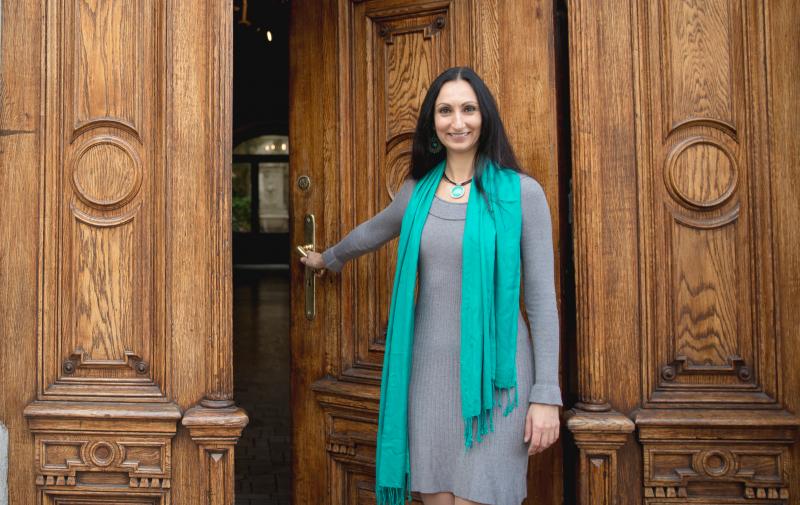“Language shapes our reality. But not just our first language. Every language we learn adjusts the limits of our world. When we learn Italian, we acquire a new linguistic and cultural identity.” – Tania Troyan, founder of the 3D method
We’ve all been that person who has rushed to buy a teach-yourself-Italian book or download the latest language-learning software spurred by a memorable trip to Italy or by seeking a connection with a long-lost family member. The passion is there, but issues of motivation, challenging grammar that has you questioning how you even speak one language fluently, and the lack of actually getting to speak the language are true cumbersome roadblocks. It is easy to see how the mammoth task of learning a new language as an adult can become overwhelming and disappointing when you fumble over even the most basic conversation at a local ristorante.
Force-feeding yourself vocabulary and grammar rules might make it easier to read Italian, sure, but what about garnering the soul of the language?
Don't give up on Italian until you have tried this
Tania Troyan, the founder of 7-week Italian and the creator of the 3D method, has seen so many people give up on learning Italian, that she decided to do something about it. Her mission stems from her own love story with Italian and a lifelong fascination with the mechanisms of the human brain involved in language learning.
“For as long as I can remember languages have always been my biggest passion. I am fully proficient in four languages and have studied at least another five. Since a very young age, I was fascinated by how the human brain processes and manages multiple languages” Tania shared. “I grew up and became a linguist, a translator, an interpreter, and a teacher and my focus has always been on the Italian language, my greatest passion”.
Over the years Tania was exposed to a wide range of language teaching methodologies. Very early on she realized something was missing for her in the way languages are traditionally taught to adults. She thought it strange that most methods focus on the language, but very rarely address the actual needs of the learner, or take into consideration the difficulties adults have when approaching a new language.

How come, she kept asking herself, we don’t include in the process of teaching Italian, or any other language, the appropriate learning tools, and techniques? Why is the learner expected to figure out how to learn: process, retain and use new information (like grammar and vocabulary) on their own? And what about thinking in Italian? It’s fundamental but almost never addressed!
As adults, we process information in such a different way from when we were children. Why do teachers, textbooks, and programs insist on teaching languages as if we were still children, able to absorb new linguistic information instinctively, through imitation? There is so much we know about neurolinguistics and psycholinguistics now! Why not use that knowledge in the teaching process?
This train of thought had her researching and creating a teaching methodology based on her own experience and focused on the needs of the students in addition to the mechanisms of the language. That's how the 3D method started taking shape.
How to fast-track your progress in Italian
Tania is always excited to share the fundamentals of her 3D method. Twice a year she opens the doors to her online school “7-week Italian” to everyone, free of charge, and shares with aspiring and experienced learners of Italian the tools, techniques and the mindset they need to adopt in order to accelerate their path towards fluency.
We asked Tania to share some tips for learning Italian successfully.
“While it is important that the program you are following is created with a valid methodology, there is so much you, as a student of Italian, can and should do on your side to accelerate the process!”, she says before sharing with us some of her suggestions.
7 keys to learning Italian successfully
Get clear on your WHY
The first thing you need to clarify when starting any new project is the reason you are doing it. Usually, students define it as “I would like to speak Italian fluently”. While it is natural to think in these terms, it is not enough. What is your motivation, your why? It has to be defined in emotional terms because as human beings we respond best to things that trigger our emotions. How would it make you feel when you reach your final goal? You need to have it as a clear statement, a sentence that describes the outcome that you desire. “I am learning Italian because I would like to feel closer to my Italian spouse” or “to reconnect with my roots”, to “feel at home in Italy”.
Define your ultimate goal and your next objective
“Non esiste vento favorevole per il marinaio che non sa dove andare” Seneca. (If a sailor knows not the destination, no wind is favorable). You are about to spend a lot of time, resources, and effort to reach a certain goal. That learning objective needs to be defined. What is the level you would like to reach? It does not have to necessarily be a full proficiency. You can work towards conversational fluency or basic linguistic survival skills, or maybe you do want full proficiency? The final goal can be readjusted but at any point of your journey, you need to have it in mind. As it is still a pretty big thing to be aiming towards, you need to break it into smaller and more achievable milestones. Always have in mind your next short-time objective. For example: “I would like to be able to introduce myself to strangers and be able to have a light conversation by the end of the year”. “In six months I would like to be able to spend a weekend with my partner speaking only in Italian”. “In 2 months I would like to walk into a restaurant in Florence and order in Italian”. The objective has to be something that excites you, something you are actually looking forward to. Again, the emotional trigger is key here.
Set accountability anchors
Once you have your motivation statement, your final goal defined and the next objective clear, it’s time to set up some accountability anchors. Your objective has to come with an “anchor” to your reality. That trip to Italy, that weekend in Tuscany, that evening in the restaurant you have decided to work towards need to be scheduled and put into your calendar. Reservations need to be made and flights booked. When it has a date and a time and maybe a ticket attached to it, it becomes real. And a real, tangible, actual milestone is infinitely much easier to work towards and achieve than an abstract one!
Adopt the right mindset and make mistakes
As in any powerful transformation process, in learning Italian you will find yourself struggling against resistance, fear, limiting beliefs and more or less successful attempts at self-sabotage. “I am too old”, “My memory is bad”, “I won’t be able to progress”, “I am probably not going to move beyond this plateau”, “I am just not capable”. “ Sounds familiar? And what about that paralyzing all-consuming fear of making mistakes that keeps you from speaking? It’s important to remember that your so-called “lizard brain”, the limbic system in your brain, wants to keep you safe in the tranquillity of your comfort zone. It will resist every time your path toward Italian fluency will push you outside the boundaries of your comfort zone. But using Italian actively means sometimes being kicked out of your comfort zone altogether. The only way to overcome this is to keep alive that flame of motivation and passion for the language. You can not get rid of the fear, but you can find something much stronger. Every time you feel resistance, negative or self-sabotaging thoughts, remember, it’s not you. It’s the reaction of your limbic system to your growth. That’s why mindset is key. Acknowledge this mechanism that is there to protect you, but decide you will do it anyway, because it makes you happy and because you choose to believe in yourself.
Fall in love
Out of hundreds of thousands of people who decide to learn Italian, very few keep going long enough to see actual results. Even fewer reach their goals. That first passion and motivation wear out very quickly when you realize how much work is involved and how much commitment is required. How can we keep that passion alive and strong enough to overcome the difficulties of language learning? There is only one answer… fall in love. If you are absolutely and completely in love with the language, you won’t mind spending hours on irregular verbs. Every moment in which you can be part of the language by using it, or listening to it will be filled with joy. Remind yourself every day why you are in love with Italian, do things that make your heart beat faster, whether it’s singing along with Andrea Bocelli or planning out your next Tuscany wine tour or Rome getaway. Anything that keeps you in love will do the trick. Keep alimenting that love and it will never wear out!
Structure your time
“I will just learn Italian when I have some time”. Sounds familiar? Then you must know it means you will never learn consistently. You might do some work here and there, but it will never be structured enough and the results will probably not be satisfying. If you are really in love with the language, you will spend every living and breathing moment around it, right? Yes, in a perfect world. In reality, life happens and we get distracted and overwhelmed and keep pushing that moment when we will finally get to spend some time working on our Italian. First of all, to see the progress you need to dedicate time, even if it's just 30 minutes, on a daily basis. Open your agenda or your digital calendar and block our time slots for your Italian. You will need one hour a day, a longer time, maybe 2-3 hours on the weekend, for a weekly review and half a day, or ideally a whole day, on a monthly basis, again, for review. Treat these time slots as romantic dates. Do not skip, do not reschedule, do not accept other engagements. After all, when you are in love with someone, you would want to spend as much time as possible with them! Spend your day looking forward to that date and remind yourself how happy it makes you feel.
Get support and guidance
Teaching yourself a language is like learning to swim from a book. While it is undoubtedly possible to make some progress, to learn some words, to get the hang of some grammar topics by using apps or textbooks if you want to avoid wasting time and feeling frustrated, get support and guidance. Today we have access to an infinity of resources online. It is wonderful, time-saving, and even game-like, but it can also be very confusing. Many students when they come to our school share their journey and tell us about spending years with apps and books, and sometimes even in-person classes, and yet have nothing to show for it. Very often it’s easier to start from scratch, from a tabula rasa situation with a complete beginner, than to reshape and restructure crystalized learning patterns. Get guidance. Find a program, a teacher, or a community. Find a system that works for you and let yourself be guided towards your goals.
In bocca al lupo! Good luck!
If Tania's approach resonated with you, and you would like to learn more about her Italian language programs designed and delivered with the 3D method, you can start with the 7-week Italian Incubator, her program for beginners and self-taught learners.
Learn more about Italian Incubator
Listen to students share their experience of learning with the 3D method













